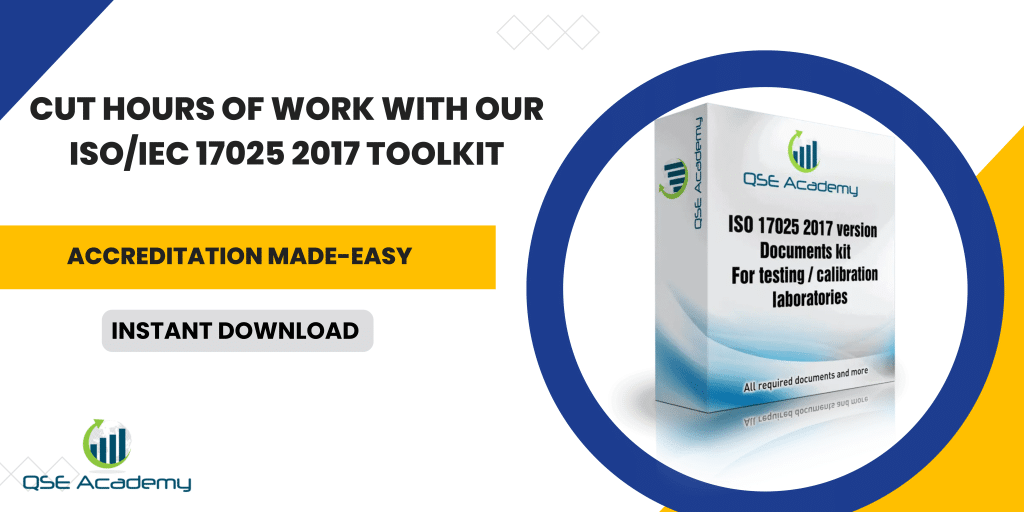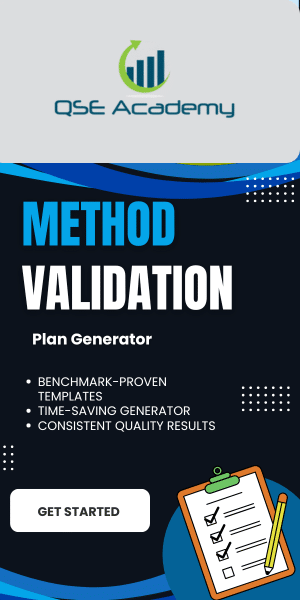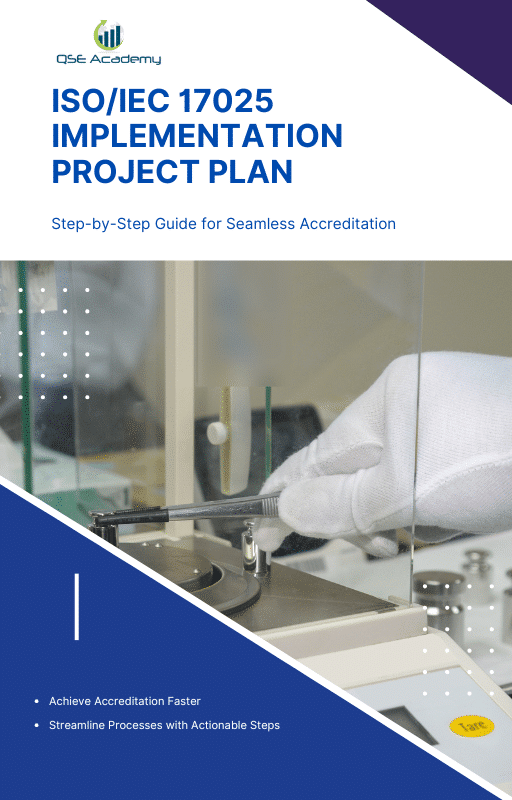ISO/IEC 17025 Transition Gap‑Analysis Template
Last Updated on October 13, 2025 by Melissa Lazaro
Why a Gap Analysis Is the First Step in the ISO/IEC 17025:2017 Transition
Every successful ISO/IEC 17025 transition starts with one essential step: knowing exactly where you stand.
When labs move from the 2005 to the 2017 version, most rush straight into rewriting documents or retraining staff. But without a proper gap analysis, they end up working twice as hard fixing the wrong things.
A gap analysis is your roadmap. It tells you which parts of your system already meet the new requirements and which areas still need attention. Done right, it prevents wasted effort, reduces audit stress, and gives you a clear direction for your transition project.
I’ve seen labs skip this step and pay for it later—discovering during their accreditation audit that something as simple as impartiality risks or decision rules weren’t fully addressed. On the flip side, labs that started with a thorough gap analysis had smoother audits, fewer nonconformities, and much less panic.
The best part? You don’t need to overcomplicate it. With a structured gap-analysis template, you can compare your old system to ISO/IEC 17025:2017 clause by clause, score your compliance level, and turn the results into a practical action plan.
Think of it as your GPS for the transition—it shows where you are, what’s missing, and the fastest route to full compliance.
Understanding What a Gap Analysis Really Means Under ISO/IEC 17025:2017
A gap analysis isn’t just a checklist—it’s a mirror. It shows how your current system stacks up against the requirements of the 2017 version of ISO/IEC 17025, and more importantly, how effectively it’s working in practice.
Under the 2005 version, many labs treated internal reviews like paperwork: check the boxes, file the form, move on. But the 2017 version changed the tone. It’s now about performance and risk-based thinking. The question isn’t “Do you have this procedure?” — it’s “Does this procedure help you produce reliable, impartial results?”
That’s where the gap analysis fits in. It’s your opportunity to evaluate both sides:
-
Compliance: Are all the required clauses covered?
-
Effectiveness: Are the procedures doing what they’re supposed to do?
Here’s what a strong ISO 17025 gap analysis does:
-
Highlights areas where your system already aligns with 2017 (so you don’t waste time fixing what works).
-
Identifies outdated or redundant controls left over from 2005.
-
Reveals opportunities for improvement and smarter documentation.
In my experience, the best labs use their gap analysis as a living document. They update it as they implement changes, using it as both a tracker and a communication tool. When assessors later ask, “How did you manage your transition?”—the completed gap-analysis file answers that question for you.
Pro Tip: Don’t treat the gap analysis like an audit report. Treat it like a blueprint—it’s there to guide your upgrade, not to judge it.
Step-by-Step Process for Conducting an ISO/IEC 17025 Gap Analysis
A good gap analysis isn’t about filling out a spreadsheet—it’s about asking the right questions. The clearer and more systematic your process, the faster you’ll identify what truly needs attention before the transition audit.
Here’s the step-by-step approach I recommend when guiding labs through it:
Step 1: Gather Your Current System Documents.
Start by collecting everything you currently use to manage quality—manuals, SOPs, calibration logs, audit reports, training records, and forms. You can’t analyze what you can’t see. Having your entire system visible helps you spot outdated documents instantly.
Step 2: Compare Clause by Clause with the 2017 Standard.
This is where your gap-analysis template becomes your best friend. Review each ISO/IEC 17025:2017 clause and check whether your current procedures meet the new requirements. Mark each as:
-
Conforms – fully compliant, no change needed
-
Partial – meets the intent but needs an update
-
Missing – no evidence or control in place
This gives you a clear, objective picture of your current state.
Step 3: Score and Prioritize.
Not all gaps carry the same weight. Missing a training record isn’t the same as lacking a documented decision rule. Assign a simple rating or color code (green/yellow/red) to show which areas pose the biggest risks to compliance.
Step 4: Assign Responsibilities and Timelines.
A gap without an owner will stay a gap. Assign each action to a specific person—usually your Quality Manager, Technical Manager, or Section Head—and set deadlines. This keeps accountability visible and progress measurable.
Step 5: Review with Management.
Once your analysis is complete, discuss it in a management review meeting. This step connects your findings to resources—because fixing gaps often involves training, equipment calibration, or documentation updates that need budget and planning.
When you follow these steps, your gap analysis turns into a strategic roadmap—not a bureaucratic exercise. You’ll know exactly what needs fixing, who’s responsible, and how to track completion.
Common Mistake: Some labs stop after filling in the template but never act on the results. Remember: the document is just the start. The real work happens when you close the gaps it exposes.
Key Areas Where Labs Typically Find Gaps During Transition
Even well-established labs are often surprised by how many small—but important—gaps show up once they compare their old system to ISO/IEC 17025:2017. The issue isn’t poor quality; it’s that the 2017 version asks labs to think differently. It focuses more on performance, risk, and impartiality than on rigid procedures.
Here are the areas where I most often see gaps appear during a transition:
1. Impartiality and Confidentiality
The 2017 version elevated impartiality from a passing mention to a core requirement. Many labs still treat it as a policy statement rather than a managed process. Assessors now expect to see how you identify, evaluate, and control risks to impartiality—and how you protect client data in practice, not just on paper.
2. Risk-Based Thinking
This is easily the most common weak point. Under the old version, risk wasn’t even mentioned; now, it’s everywhere. Most labs haven’t yet created a clear method for identifying and recording risks that could affect quality or impartiality. Even a simple risk register can close this gap quickly.
3. Decision Rules and Statements of Conformity
This requirement is new and often misunderstood. Labs need to define how they decide if a result conforms to a specification, including how measurement uncertainty is considered. Without a documented approach, you’ll likely get a nonconformity during your next assessment.
4. Measurement Uncertainty and Traceability
Labs often discover that their uncertainty calculations haven’t been reviewed in years—or that traceability documentation doesn’t fully meet the 2017 expectations. These technical details now carry more weight, so updating records and validation methods is essential.
5. Competence Evaluation
Training records alone no longer prove competence. You now need to show how you evaluate technical ability—observations, proficiency tests, or performance monitoring. This is one of the biggest mindset shifts of the new version.
6. Document Control and Flexibility
The 2017 version gives labs freedom in how they manage documented information—but that flexibility can create confusion. Some labs over-control documents, while others don’t control them enough. You need a balanced, clear process that ensures current versions are used consistently.
In my experience, these six areas account for nearly 80% of the gaps during transition. If you focus on them first, you’ll see measurable progress fast—and your assessors will notice.
Pro Tip: As you review these areas, write a short summary in your gap-analysis report for each. It makes your transition plan easier to present to management and accreditation bodies.
Using the ISO/IEC 17025 Gap-Analysis Template Effectively
Having a template is one thing—using it well is another. I’ve seen labs download a checklist, fill in a few boxes, and call it a “gap analysis.” That’s not what ISO 17025:2017 expects. The real value comes when you use the template as a thinking tool, not just a form.
Here’s how to get the most out of it:
1. Understand the Structure Before You Start.
A good gap-analysis template should be simple but complete. The most useful versions include:
-
Clause Reference – which part of ISO/IEC 17025:2017 applies.
-
Requirement Summary – what that clause actually asks for (in plain language).
-
Current System Status – what your lab currently does.
-
Gap Identified – what’s missing or needs updating.
-
Corrective Action & Responsible Person – who will fix it, and by when.
Color-coding helps:
🟩 Green for conforming, 🟨 Yellow for partial, 🟥 Red for missing.
It gives management an instant visual snapshot of where attention is needed.
2. Record Evidence, Not Opinions.
Avoid vague notes like “needs improvement.” Write down what you observed—for example:
“No documented risk assessment for impartiality in supplier selection.”
That specificity turns your template into actionable data, not guesswork.
3. Use It as a Discussion Tool.
The template isn’t just for the quality manager. Review it as a team—technical staff often see gaps that management overlooks. When everyone contributes, you get a clearer picture and stronger buy-in for the changes ahead.
4. Turn Each Gap into an Action.
Don’t leave red boxes hanging. For every gap, define the fix, assign an owner, and set a due date. This transforms your template into a live transition tracker instead of a static report.
5. Keep It Updated as You Implement Changes.
Mark each action “completed” only after evidence exists—like revised procedures, training records, or risk registers. By the time your accreditation audit arrives, this template becomes proof of how systematically you managed the transition.
In short, your gap-analysis template isn’t paperwork—it’s your story of progress. It shows assessors that your lab didn’t just meet the 2017 version by accident; you built compliance step by step.
Pro Tip: Save the completed template under document control. Accreditation bodies sometimes request it during transition assessments—it’s an easy way to demonstrate traceability and intent.
Turning Gaps into a Transition Roadmap
Once your gap analysis is complete, you’ve got something powerful in your hands—a clear picture of what needs fixing. But that’s only half the job. The next step is turning those findings into a structured, realistic roadmap that guides your lab through the transition smoothly.
Here’s how to make that happen:
1. Prioritize What Matters Most.
Not every gap deserves equal attention. Start with the ones that carry the biggest compliance or operational risks—usually around impartiality, competence, and risk management. Fixing high-impact areas first builds momentum and confidence for the rest.
2. Convert Gaps into Action Items.
Take every “red” or “yellow” item in your gap-analysis template and assign it a task: what needs to be done, who’s responsible, and when it should be completed. This turns your analysis into a working project plan rather than a static report.
3. Integrate Training and Communication.
Some gaps can’t be closed with documents alone. Staff may need retraining or new instructions. Plan short sessions to explain updates, demonstrate new procedures, or clarify changed roles. When your team understands why the new standard matters, implementation becomes effortless.
4. Link It to Your Management Review.
Make your roadmap part of your management review agenda. Use that meeting to discuss progress, assign resources, and remove roadblocks. That shows assessors leadership involvement—something the 2017 version expects clearly.
5. Track Progress Visually.
Many labs I’ve worked with use a simple Gantt chart or dashboard linked to their gap-analysis template. It’s a quick way to see what’s complete, what’s pending, and what’s delayed. Plus, it helps you communicate progress easily to management or assessors.
6. Validate Before Closing Each Gap.
Don’t just tick boxes. Check that every change you make actually works—whether that’s a new procedure, training record, or risk assessment. Validation ensures your system isn’t just compliant—it’s effective.
I once helped a materials testing lab that used this roadmap approach. They turned a long list of 52 gaps into a 3-month action plan, assigning owners and timelines. By their transition audit, every major gap was resolved, and their assessor commented that their documentation “looked lived-in, not forced.”
That’s the goal: a system that feels natural, not one built to impress auditors.
Pro Tip: Rename your completed plan “ISO/IEC 17025:2017 Transition Implementation Record.” It immediately tells assessors this wasn’t random—it was managed.
Validating and Updating Your Gap Analysis Over Time
A lot of labs treat their gap analysis like a one-time exercise—something to check off the list before the transition audit. But here’s the truth: your gap analysis is never really “done.” It’s a living document that should evolve right alongside your lab.
The ISO/IEC 17025:2017 standard emphasizes continuous improvement, and that’s exactly how you should treat your gap analysis—as an ongoing tool for self-assessment and accountability.
Here’s how to keep it alive and valuable:
1. Revisit It After Each Internal Audit.
Every internal audit reveals something new—maybe a small process drift, a documentation lapse, or a training need. Update your gap analysis after each one. Over time, it becomes a visual record of how your system has matured since the transition.
2. Use It to Track Improvements.
Your gap analysis isn’t just about what’s wrong—it should also reflect progress. Highlight completed actions, note reduced risks, and document performance improvements. This gives management and assessors clear proof that your system is continuously improving.
3. Version-Control the Document.
Keep track of each revision of your gap-analysis file. Label updates with dates and the reason for changes—“Post-internal audit,” “After surveillance assessment,” or “Annual review.” This simple habit creates traceability, which assessors appreciate.
4. Link It to Future Planning.
The insights you gain from periodic reviews can feed directly into your next management review or training plan. For example, if your gap analysis keeps showing weak points in measurement uncertainty, you might decide to focus your next training cycle there.
5. Keep Ownership Clear.
Assign responsibility for maintaining the gap analysis—typically to your Quality Manager or QMS Coordinator. Without clear ownership, updates tend to stall. Make it part of someone’s ongoing duties, not just a one-off project.
In my experience, the labs that revisit their gap analysis at least twice a year stay ahead of audit findings. It’s not about avoiding mistakes—it’s about catching them early, learning from them, and improving steadily.
Pro Tip: Label your latest version “Living Gap Analysis.” It signals to assessors that you’re not treating ISO 17025:2017 as a static achievement but as an evolving commitment to excellence.
FAQs – ISO/IEC 17025 Gap Analysis During Transition
Over time, I’ve heard the same few question from labs trying to navigate their transition. Here are the most common ones—answered based on what’s actually worked in the field.
Q1: Do we need to submit our gap analysis to our accreditation body?
Usually, no. Accreditation bodies don’t require you to submit it unless they specifically request it during the transition process. However, having it ready—and well-documented—shows professionalism and preparedness. Many assessors ask to see your gap analysis as evidence that you managed the transition systematically.
Q2: Can we use the same template for multiple lab locations?
Yes, but with one key adjustment. Each location should have its own “status” and “actions” columns. The clauses and requirements are the same, but the level of implementation might differ. This approach keeps your documentation consistent while recognizing that not all sites are equally ready.
Q3: How often should we update the gap analysis?
At least twice: once at the start of your transition and again before your transition audit. After that, use it as part of your internal audit or management review cycle—every 6 to 12 months. The more often you revisit it, the fewer surprises you’ll have during assessments.
Q4: Who should lead the process—quality or technical management?
Ideally both. Quality leads the documentation side, while technical management ensures the requirements make sense in real operations. When the two collaborate, you get a gap analysis that’s both accurate and practical.
Q5: What if our analysis shows too many “red” (non-compliant) items?
Don’t panic—that’s actually a good sign. A gap analysis is meant to reveal weaknesses. The real problem is when it looks “perfect” but doesn’t reflect reality. Be honest about your current state; assessors respect transparency far more than artificial perfection.
Pro Tip: Keep your completed gap analysis accessible during the transition audit. When assessors ask how you approached compliance, walk them through your document. It immediately demonstrates structure, control, and a proactive approach—exactly what ISO 17025:2017 promotes.
From Gaps to Confidence in ISO/IEC 17025:2017 Compliance
A solid gap analysis isn’t just a document—it’s a roadmap to confidence. It gives your lab the clarity to move from uncertainty to full control over your ISO/IEC 17025:2017 transition.
Once you’ve filled out your template honestly, prioritized your actions, and tracked your progress, you’ll know exactly where your lab stands. That’s a powerful feeling when you head into an audit—because you’re not guessing anymore, you’re prepared.
The labs that handle transitions best all have one thing in common: they don’t treat ISO as a paperwork project. They treat it as a way to make their systems simpler, stronger, and more reliable. The gap analysis is just the starting point—but it sets the tone for everything that follows.
In my experience, labs that use this structured approach not only transition faster but also perform better long-term. They end up with fewer nonconformities, better staff understanding, and smoother accreditation renewals.
If you’re starting your own transition, begin with your gap analysis—it’s the smartest move you can make. And if you want to make the process faster and less overwhelming, QSE Academy can help.
We offer:
-
Ready-to-use ISO/IEC 17025:2017 Transition Gap-Analysis Templates (customizable for your lab type),
-
Complete ISO/IEC 17025 Documentation Packages, and
-
One-on-one consultation to guide your transition plan from start to finish.
Your next step: Download your ISO/IEC 17025 Transition Gap-Analysis Template or schedule a quick consultation. A 15-minute session today can help you save months of confusion later—and get your lab fully aligned with 2017 requirements with confidence.
I hold a Master’s degree in Quality Management, and I’ve built my career specializing in the ISO/IEC 17000 series standards, including ISO/IEC 17025, ISO 15189, ISO/IEC 17020, and ISO/IEC 17065. My background includes hands-on experience in accreditation preparation, documentation development, and internal auditing for laboratories and certification bodies. I’ve worked closely with teams in testing, calibration, inspection, and medical laboratories, helping them achieve and maintain compliance with international accreditation requirements. I’ve also received professional training in internal audits for ISO/IEC 17025 and ISO 15189, with practical involvement in managing nonconformities, improving quality systems, and aligning operations with standard requirements. At QSE Academy, I contribute technical content that turns complex accreditation standards into practical, step-by-step guidance for labs and assessors around the world. I’m passionate about supporting quality-driven organizations and making the path to accreditation clear, structured, and achievable.












